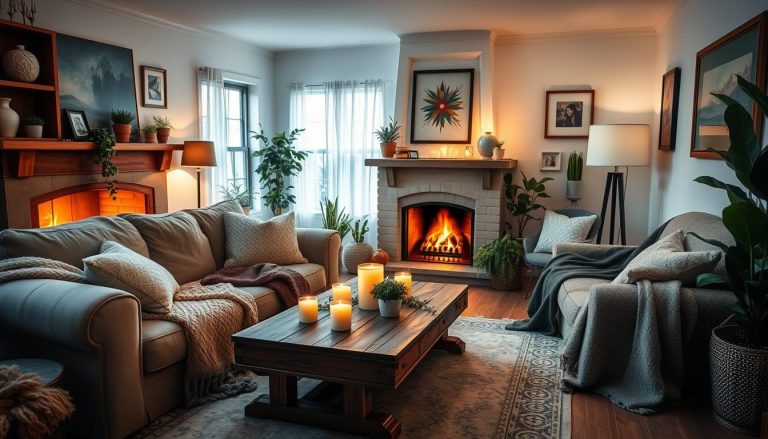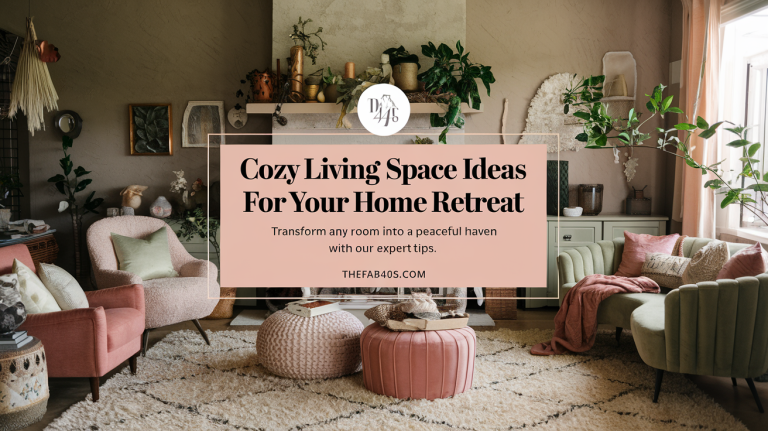Creating a Serene Meditation Room Oasis
This page may contains affiliate links. We may earn a commission for purchases made at no additional cost to you. The content on this website was created with the help of AI.
In today’s world, finding peace is more important than ever. Creating a meditation room is a great way to make a calm space. Jeremiah Brent, a famous interior designer, says it’s key for mindfulness and well-being.
Spending time each day in meditation can really help. It can lower anxiety and stress in just 30 days.
Designing a meditation room involves many elements for peace. Think about textures, scents, and lighting. Adding personal touches like essential oils and plants makes it special.
Keeping it simple and clutter-free is also important. This helps create a perfect place for quiet reflection. It shows how silence and stillness are vital in our busy lives.
Importance of a Calm Space for Meditation

A dedicated meditation space is key for mental well-being. It surrounds you with calm, helping you focus. This space can lower stress, improve concentration, and boost your brain power.
Having a special place for meditation helps you escape daily noise. It creates a space for quiet, helping you think clearer and feel more stable. Regular visits to this space make relaxation a habit.
Make your meditation space your own. Use calming colors, peaceful art, and gentle scents. Add comfy cushions, seats, and soft light to make it cozy.
In a quiet spot, you can really focus on your breath and thoughts. A well-thought-out space reminds you to relax and be mindful all day. It shows how a calm place helps your mind and spirit.
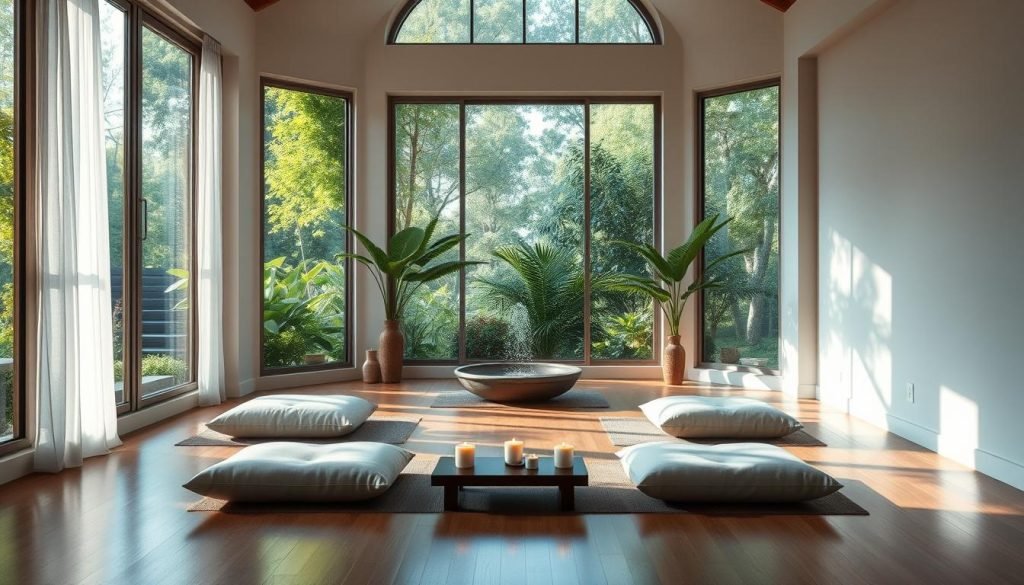
| Benefits of a Dedicated Meditation Space | Description |
|---|---|
| Reduces Distractions | A designated area minimizes interruptions, allowing deeper focus. |
| Enhances Consistency | A habitual practice in the same location builds routine and habit. |
| Encourages Personalization | Customization fosters a supportive and nurturing environment. |
| Increases Mindfulness | A visual cue for mindfulness can lead to deeper engagement in daily practices. |
| Promotes Comfort | Comfortable seating and calming elements enhance the meditation experience. |
Choosing the Perfect Location for Your Meditation Room

Finding the right spot for your meditation room is key. It should be quiet, away from daily noise. Spare bedrooms or cozy living room corners work great. This way, you create a peaceful spot for mindfulness and calm.
Light is important for a good meditation spot. Spaces with lots of sunlight are positive and connect you with nature. Adding natural materials like wood or stone makes it even more peaceful.

Using empty space makes your room calm and focused. Soft rugs, plush pillows, and cushions make it cozy. This turns any spot into a welcoming place for meditation.
| Location Option | Benefits |
|---|---|
| Spare Bedroom | Spacious, allows for personalization, minimal distractions |
| Living Room Corner | Enhances social interaction, can be accessed easily |
| Sunroom | Offers abundant natural light, connects with nature |
| Home Office | Utilizes existing furnishings, promotes a focused mindset |
| Outdoor Patio | Embraces natural sounds, fosters deeper connection with surroundings |
Having a meditation room helps you grow personally. The right spot makes your space peaceful. It helps you relax and think deeply every time.
Comfort and support are essential for your meditation space. Soft mats and ergonomic seating allow you to relax and focus during longer meditation sessions.
A Zabuton meditation mat offers a plush base, enhancing your comfort and reducing strain while meditating.
For added posture support, a luxury padded floor chair provides back support and comfort without cluttering the space.
Essential Elements of a Meditation Room
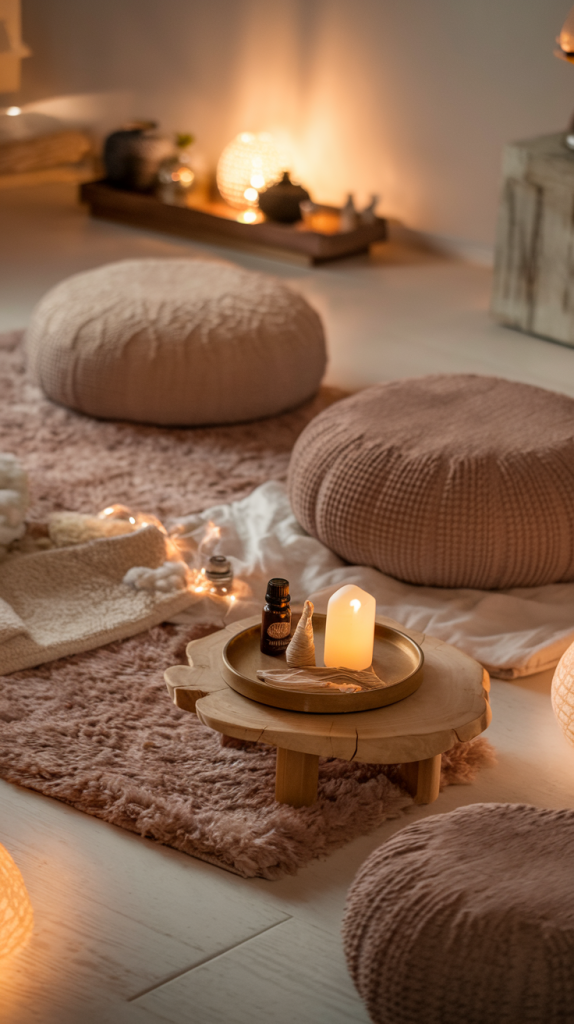
Creating a peaceful meditation space requires choosing the right items. Texture, scent, and lighting are key to a calm atmosphere. Each element is crucial for a space that invites meditation.
Texture affects how a space feels. Use soft materials like plush rugs or cushions for comfort. The Zabuton Meditation Mat, at $90, is great for a cozy base. For those who like sitting up, the Luxury Padded Floor Chair with Back Support at $55 is a good choice.
Scent adds relaxing fragrances to your space. Choose essential oils like lavender, chamomile, or citrus. The Guru Nanda Aromatherapy Essential Oil Starter Kit, at $50, offers calming scents. Candles, like the Uplifting Soy Wax Candle for $11, can also enhance the scent.
Lighting sets the mood. Mix natural light with soft ambient lighting for peace. The Koshi Chime Ignis at $80 adds soothing sounds. Soft lighting can be improved with the Moon Glow Wall Hanging, priced at $85. These elements create a calm space for meditation.

In summary, texture, scent, and lighting are the core of a meditation room. With careful selection, even small spaces can become peaceful retreats. This helps in regular meditation, leading to mental clarity and peace.
The right scents can elevate your meditation experience, creating an atmosphere of calm and relaxation.
The Guru Nanda aromatherapy essential oil starter kit includes a variety of calming oils, such as lavender and chamomile, perfect for your meditation practice.
For a soft, warm glow and subtle scent, the uplifting soy wax candle adds both ambiance and relaxation to your space.
Color Palette: Transforming Your Meditation Room
The right color palette can turn your meditation room into a calm sanctuary. A calming color palette is key to creating tranquility. Soft hues like blues, greens, and earth tones make a peaceful space for meditation.

Here are some popular meditation color palettes to inspire your design:
| Palette Name | Color Scheme | Ideal For |
|---|---|---|
| Tranquil Dawn | Soft pastels and deep purples | Spaces that inspire calm and reflection |
| Serene Ocean | Cool blues and greens | Tranquil, seaside-like ambiance |
| Zen Garden | #E3F6E5 and #B7E4C7 | Eco-friendly interior spaces |
| Mystic Twilight | Soft pastels and bold purples | Modern web designs |
| Calm Sunset | Warm hues from #F9D5A0 to #A03A4D | Intimate wedding themes |
| Sacred Earth | #D9CBAE and #BFAF8D | Minimalistic branding |
| Blissful Breeze | Soft neutrals with rich browns | Creative projects |
| Harmonious Forest | Greens from #C8E6C9 to #388E3C | Spa branding |
| Ethereal Light | #FCE4EC and #F8BBD0 | Seasonal promotions |
| Peaceful Sky | Blues from #BBDEFB to #2196F3 | Lifestyle branding and tech products |
| Gentle Rain | #E1F5FE and #29B6F6 | Boutique interiors |
| Spiritual Flame | Warm reds and pinks | Casual apparel lines |
| Radiant Aura | Warm purples and cool lavenders | Artisan product branding |
| Celestial Harmony | Cool blues and teals | Festival marketing |
| Vibrant Energy | Warm yellows and oranges | Tech startups and cozy interior spaces |
It’s important to avoid patterns that are too stimulating. Soft colors in your meditation room design help with relaxation and mindfulness. Benjamin Moore’s Color of the Year for 2022, October Mist, is a great example of serenity. With over 80 searches for meditation room color schemes on Pinterest, many want to use calming colors to improve their meditation.
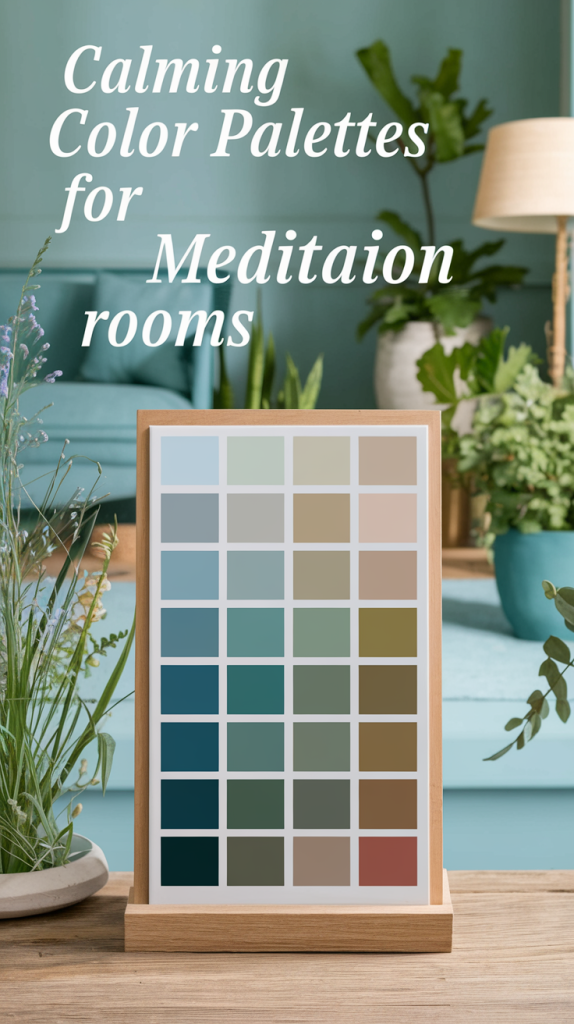
Soft, calming colors can make your meditation room feel like a true sanctuary. Neutral or pastel hues promote relaxation and focus.
Benjamin Moore’s October Mist is a serene, muted green that works beautifully for meditation spaces.
Enhance the mood with calming wall art, featuring nature scenes or abstract designs in soothing colors.
Incorporating Natural Elements into Your Meditation Room
Adding natural elements to a meditation room makes it a peaceful oasis. Indoor plants not only look good but also freshen the air. They help clear your mind and bring calm.
Using organic materials like wood or stones connects you to nature. This connection is vital for a peaceful space. For example, a wooden bench can be both a place to sit and a beautiful centerpiece. Adding natural light makes the room welcoming and cozy.
A small fountain on a table can add calming sounds. The sound of water improves your meditation experience. It follows Vastu Shastra’s rules for peaceful meditation areas.
Choosing soft colors like light blue or green helps too. These colors bring serenity and fit well with Vastu and Ayurveda. They let you express your style while staying true to nature.
- Incorporating indoor plants enhances air quality and tranquility.
- Utilizing organic materials fosters a connection with nature.
- Adding water features instills auditory serenity.
- Choosing calming colors influences mood positively.
- Personal touches can enhance the peaceful vibe of the room.
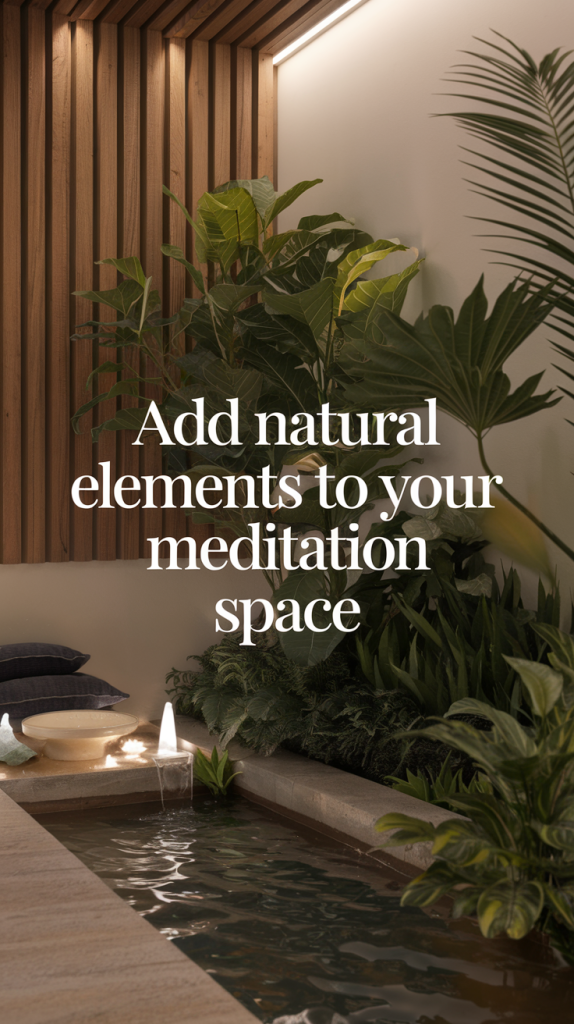
By focusing on these elements, your meditation room becomes more than just a place for mindfulness. It becomes a peaceful retreat that feels like a natural haven.
Bringing natural elements into your meditation room enhances tranquility and improves air quality.
An indoor snake plant is low-maintenance, purifies the air, and adds a touch of greenery to your space.
A tabletop water fountain introduces calming water sounds, perfect for deepening your meditation experience.
Creating a Minimalist Design for Clarity and Calm
Creating a minimalist design in your meditation room is key for clarity and calm. It focuses on simplicity and a clean space. This lets your mind fully focus on meditation.
A calm atmosphere helps you relax deeply and think clearly. This is crucial for mindfulness.
To get a minimalist look, use neutral colors like whites, beiges, or soft grays. These colors make the space calm. Choose simple seating like floor cushions, yoga mats, or poufs. They add comfort without cluttering the room.
Adding natural elements makes the space even better. Wood, bamboo, stone, and plants make the room beautiful and calm. Pick easy-to-care-for plants like snake plants or rubber trees. They help relax you and clean the air.
Lighting is also very important. Soft, warm lights create a gentle glow for meditation. Using indirect lighting or candles adds to the calm. It also helps with emotional balance by letting in natural light.
Textiles like rugs and cushions add warmth and comfort without making the room messy. You can change the design easily. Adding personal touches makes the room your own.
Setting up your meditation room doesn’t have to cost a lot. You can do it bit by bit, finding affordable items. A minimalist design means making thoughtful choices. It creates a clean space for calm and focus.
Lighting Choices for Your Meditation Sanctuary
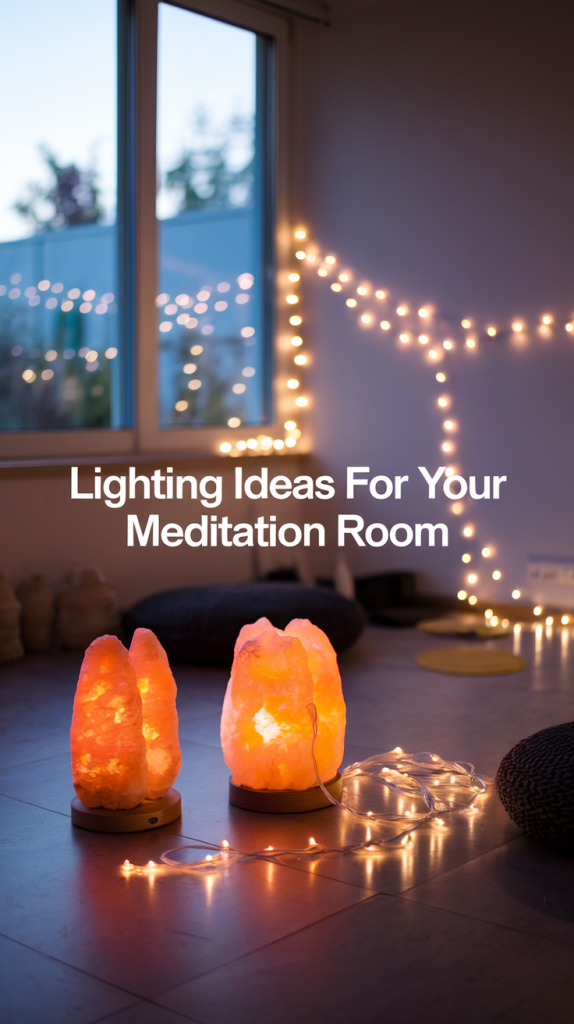
Effective lighting for meditation is key to a calming space. The right lights make the room feel cozy and support mindfulness. Options like candles, Himalayan salt lamps, or fairy lights create a warm, relaxing vibe.
Natural light is also important. Placing your meditation area near windows or skylights brings in daylight. This mix of light and nature creates a peaceful, connected space.
When setting up your meditation room’s lighting, think about these:
- Candles: Offer a soft glow and add calmness.
- Himalayan Salt Lamps: Give off soft light and help purify the air.
- String Lights: Can make the room feel whimsical or cozy, depending on where you put them.
- Dimmer Switches: Let you change the light’s intensity to match your mood.
- Natural Lighting: Use windows and sheer curtains to let in plenty of natural light.
Choosing the right lighting is crucial for your meditation room’s look and feel. Mixing natural and soft lights creates a space that feels just right for you. This setup helps you dive deep into your meditation practice.
| Lighting Type | Description | Benefits |
|---|---|---|
| Candles | Natural source of light, often scented | Creates a soothing and warm atmosphere |
| Himalayan Salt Lamps | Soft light from a natural salt crystal | Promotes tranquility and purifies air |
| String Lights | Twinkling lights on a wire | Adds a playful and cozy element |
| Dimmer Switches | Adjustable brightness settings | Allows for mood customization |
| Natural Light | Sunlight shining into the room | Enhances mood and energy levels |
Thinking carefully about lighting for meditation helps create a space where you can relax and focus on mindfulness.
Lighting sets the mood for a meditation space. A mix of soft, ambient lighting and natural light enhances tranquility.
A Himalayan salt lamp offers a calming, warm glow while helping to purify the air.
To add a visually soothing element, a moon glow wall hanging creates a peaceful, celestial atmosphere.
Scent and Sound: Enhancing the Meditation Experience
Creating the right atmosphere in a meditation room is more than just visual décor. The scent and sound are key to deepening your practice. Essential oils like Lavender and Eucalyptus can bring calm and focus. They turn a simple space into a sanctuary, affecting your brain’s neurotransmitters for relaxation and happiness.
Meditation sounds, such as water fountains or nature playlists, add to the tranquility. Ambient soundscapes, like the rustle of leaves or rain sounds, help you focus inward. These elements help mask distractions, letting your mind settle into a meditative state.
Throughout history, cultures have used calming aromas and sounds to enhance meditation. You can use aromatic oils, scented candles, or sound machines. These elements can profoundly impact your meditation, making it a peaceful retreat.


